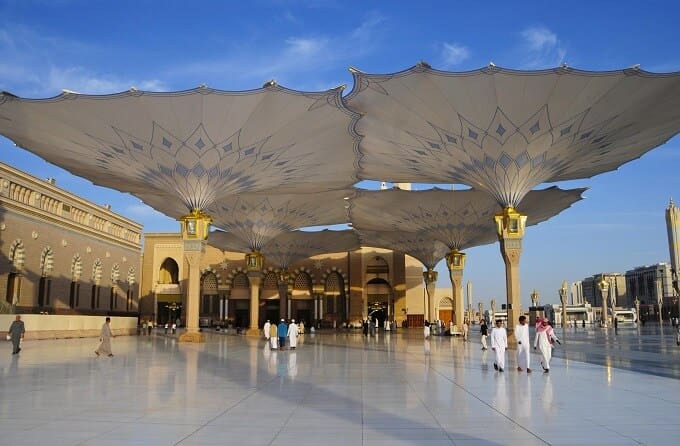Located in Al Madinah, Saudi Arabia, Al-Masjid al-Nabawī is one of the largest mosque in the world, the Islam’s second-holiest mosque built by the Prophet Mohammed. Over the centuries, Al-Masjid al-Nabawī was enlarged, though it couldn’t kept pace with the increasing swell of Hajj pilgrims who gather each year in its courtyards. Millions of pilgrims congregate in the two interior courts belonging to both the old mosque and the new, traditionally designed buildings in Medina al-Munawwarah.

Just imagine a little bit how it looks like its surrounding area when the time of pilgrimage arrives. Although in recent years the traditional time of pilgrimage has been in the cooler fall and winter months, this period is changing progressively according to the lunar calendar and the summer months when temperatures are extremely high returns, exceeding 120 degrees F. These marble-floored spaces can be punishing for those millions of pilgrims who gather here, so these open plazas had to be efficiently climatized.
To such an exceptional situation, there had to be an exceptional solution and German designers, SL-Rasch, in collaboration with SEFAR Architecture came up with an ingenious way that improved the mosque’s natural micro-climate without destroying its architectural character. In November 2010, they completed the plantation of a forest of giant foldable sunshades, each being almost 20 meters tall. They were the largest umbrellas built up to that time and are really something unseen. The members of the Medina Haram Piazza project, as it was named, include general contractor Saudi Binladin Group (SBG), customer Saudi Arabian Ministry of Finance, architect SL-Rasch, German umbrella manufacturer Liebherr and Japanese manufacturer Taiyo Kogyo.

The stunning umbrellas work together to constitute the convertible shading roof of either of the mosque’s courts, having a total of 143,000 m2, which is larger than the floor area of the mosque itself. To have the expected result and provide pilgrims with optimal shade and environment, the high tech sunscreens are made of a special material named PTFE fabric, which satisfies the rigorous standards required by the customer and resist the aggressive UV radiation. Besides that, the material has an extremely high tensile strength owing to wind load, colorfastness, fire resistance, maximum flexibility, as well as effective shading and appropriate light transmission.
Regarding the light that passes through them, this extra tough PTFE fabric is a sand-colored one due to some good reasons. Additionally, the umbrellas feature elegant columns and oriental patterns made from blue PTFE ribbons, applied to the underside of the umbrella. The result of this solution? The ambient temperature created by the transclucent sunshades was decreased with at least 8 °C. Like blooming flowers, they all are programmed to open and close simultaneously in minutely delayed sequence to avoid collision between their moving parts. This procedure takes three minutes, offering a fascinating scene to watch.




Photos © Sefar Architects




5 Comments